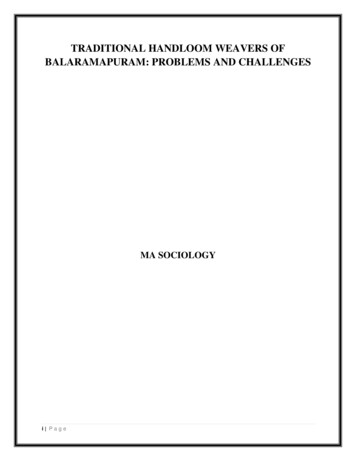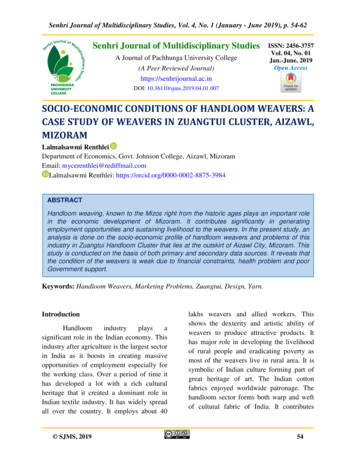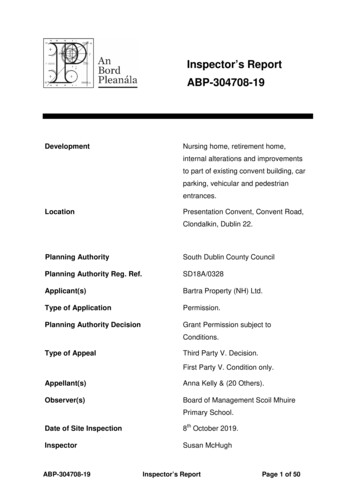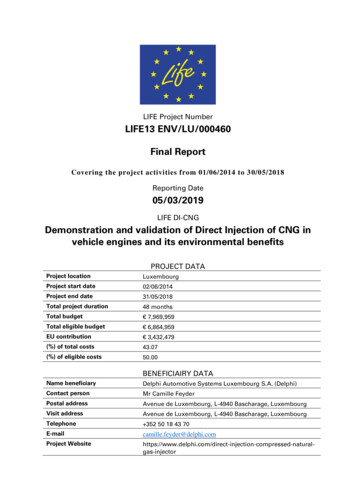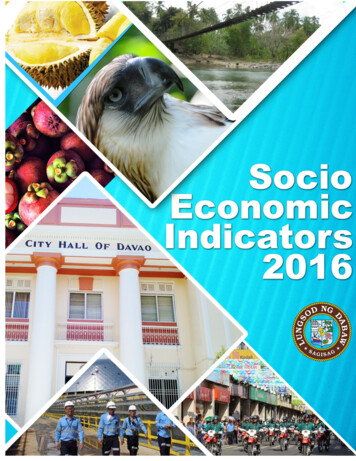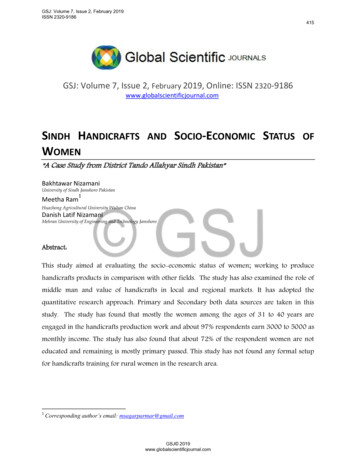
Transcription
International Journal of Pure and Applied MathematicsVolume 119 No. 16 2018, 1411-1423ISSN: 1314-3395 (on-line version)url: http://www.acadpubl.eu/hub/Special Issuehttp://www.acadpubl.eu/hub/SOCIO ECONOMIC CONDITION OF HANDLOOM WEAVERS: A STUDYWITH SPECIAL REFERANCE TO HANDLOOM WEAVERSCO-OPERATIVE SOCIETY INKANNUR DISTRICT*Shamitha.K. V, **Dr.P. Balasubramanian*Research scholar, Dept. of commerce and management, Amrita Viswavidyapeetham,Kochi.E-mail: shamithasatheesh1985@gmail.com**Assistant Professor (Sr. Grade) and Head, Dept. Of commerce andmanagement, Amrita Viswavidyapeetham, Kochi.E-mail- baladiwansapudur@gmail.com11411
International Journal of Pure and Applied MathematicsSpecial IssueSOCIO ECONOMIC CONDITION OF HANDLOOM WEAVERS: A STUDY WITH SPECIALREFERANCE TO HANDLOOM WEAVERS CO-OPERATIVE SOCIETY INKANNUR DISTRICTABSRACTHandloom sector is an important second position employer in the country afteragriculture. More than 16 million weavers are living with the help of handloom. Accordingto the census 2011 it is estimated 833 million people are currently lives in rural India. Nowmore than 35million weavers and more than 150000 weaver’s co-operative societies arebuild upon their dreams with the support of the handloom industry. The handloom industryis expanding both nationally and internationally because of the demand for hand craftedartefacts and unique traditional design. This study is concentrated in Kannur district ofKerala. Kannur is the place where “city of looms and lore’s”. That is Kannur is also a majorhandloom weaving region of India. In Kannur region there are 37 weaver’s co-operativesocieties, provide an employment opportunity to around 2600 members. These 37 weaver’ssocieties are categorized to above average, average, below average. The major products ofKannur handloom are table linen, kitchen linen, bed linen, furnishing articles, curtains, toiletlinen, fabrics. Government intervention of this sector is endless. A lot of welfare measuresand schemes are introduced by government. In spite of various schemes implemented thehandloom industry facing a lot of problem, that is competition from global marketing, lowlevel of income, poor market price. So as the development of social and economicconditions of weaving communities are not improved. They faced more vulnerablyespecially due to weak organizational structure, low wages, poor infrastructure,decentralized looms, poor marketing etc.Key words: Handloom sector; weavers; socio economic condition; problems of handloomsector.1. INTRODUCTIONIndia has long tradition in weaving especially in hand weaving. We are moving throughdifferent diversity; handloom is one of that. Also handloom is one of the cultural heritage ofIndia. This shows the dexterity and artistic ability of weavers to produce attractive products.Handloom always promotes innovations in its products through experimentation andexhibitions. Through its uniqueness and peculiar design, the handloom sector is well knownindustry in all over the world. Handloom sector has rich cultural heritage so it created adominant role in Indian textile industry. Considering its contribution handloom sector hasthe space near by agricultural sector. It has major role in developing the livelihood of ruralpeople and eradicating poverty because most of the weaver’s society are situated in ruralarea. It provides employment opportunity to lakhs of weavers and allied workers. It helps toreducing the discrimination of men and women. Lot of women workers are working inhandloom industry. It makes a platform to reduce the gap between rural and urban people.21412
International Journal of Pure and Applied MathematicsSpecial IssueHandloom industry are producing ecofriendly energy saving products the outcome isenhancing the sustainable development. The production of handloom fabrics in the year2014-2015 are 7203 million sq. meters and exports are 2246 crores.Weavers co-operatives gave the different ways for dormant in rural and regionallevel population. Thus co-operative provide a ready tool for addressing member’sdifficulties.Generally speaking, a co-operative society is a business organization in which groupof persons are associate together for common interests jointly sanctioned to come togetherwith the common goal of promoting their financial activities such as production, distributionor marketing of goods and services, and provision of satisfying welfare measures to theirmembers. Co-operative as an autonomous association of person voluntarily meet togetherfor common interest. The main motive of co-operative society is serving people not formaking profit. So as that co-operative society is a generous one in our society.In Kannur district lots of co-operative societies are working in financial sector.Kannur the northern district of Kerala, is popularly known as the “city of looms and lore’s”,“town of export excellence” etc. Due to its unending relation with handloom industry. Theindustry is spread in37 Panchayath and 5 muncipalities. Out of this 37 weaver’s co-operativesocieties are working. There is ample scope for fabrics in world market which is exclusivelyreserved for handloom industry. The Kannur handloom includes the co-operative societiesboth industrial and primary; Khadi units and unorganized individual units. Cloth can beproduced by using both handlooms and power looms. Power looms are being morecommon in the private sector; the handloom are dominant in the co-operative sector.2. REVIEW OF LITERATURE1. D. Srinivasa Rao and Dr. N. Sreedhar (sep.2017) studied about “socio economic conditionof handloom weavers in Gannavaram Mandal of Krishna district in Andrapradesh. Thisstudy is based on extensive field work indicates that though handloom weaving has manystrengths and can be competitive under specific condition, the seeds of the crisis areinherent in the sector. These can be traced to two major factors the low performance of theco-operative sector, and the very low economic condition of the weavers.2. Dr. Dharam Chand Jain and Miss Ritu Gera (Jan.2017) conducted a study about “Ananalytical study of handloom industry of India”. In this study they can found someproblems related to handloom industry. Lack of adequate and authentic data, poor qualityof yarn, financial crisis, lack of proper infrastructure, lack of education, skills based trainingand research, shortage of input and their rising cost, problem of working capital, poormanagement.3. K. srinivasalu (1994) conducted a study in “handloom weavers struggle for survival”. Inthis study the researcher identified a serious threatens is happening against handloomweavers from power loom weavers. Already seriously threatened by the unequalcompetition from power loom sector, the very survival of the handloom sector and ofhandloom weavers has now been imperiled by the sharp rise in prices of yarn and dyes theresult of the economic reform programmed all out emphasis on developing exports and notconsidering domestic economic and social crisis.31413
International Journal of Pure and Applied MathematicsSpecial Issue4. Md. Kairul Islam and Md. Eliias Hossain (Sep.2012) focused a study in, “An analysis ofpresent scenario of handloom weaving industry in Bangladesh”. The study analyzed thedifferent aspects and issues of handloom industries. In this study they found that thehandloom sector is raising employment opportunity in rural area and rising income,eradicating rural poverty, bringing equity in the distribution of income, substituting importsand increasing potentials for exports. How ever this industry is facing some problems whichare the reasons for non operation of looms.5. Department of Economics and Statistics of Government of Kerala (Nov.2009) submitted“A report of survey on handloom sector in Kerala”. In this study they mainly focused tostudy the socio economic impact taken place among weavers due to implementation ofvarious activities, financial assistance received by each co-operative society under variousschemes.6. Dr. A. Kumudha and Mrs. Riswana (Jan-2012) focused a study of “promotion of handloomproducts with special reference to handloom weaver’s co-operative society in Erodedistrict”. In this study they focused out that handloom is a traditional industry offeringmillions of employment opportunities to millions of weavers in India. But recently theindustry is facing lot of problem and going towards the declaim stage.7. Dr. Selvaraj A and Tamilarasi. N (May-2016) studied about “factors influencing handloomweavers to enter into the field”. The main objective of this study are1. To measure the factors influencing the handloom weavers to enter into the field.2. To offer suitable suggestions for further development.In this study a lot of factor is found to enter into this field that is heredity, easy to start,less working capital, practical knowledge, availability of raw material, availability of labour,government loan/subsidy, regular income, easy market facility, self employment, owninterest. Out of this regular income is the most important factors to enter into thehandloom field.8. Anu Varghese and M.H. Salim (May-2015) studied “handloom industry in Kerala: A studyof the marketing issue”. This study seeks to (I) study the significance of handloom industryin Kerala. (ii)study the marketing problem associated with handloom industry in Kerala.(iii)suggest suitable remedial strategies for the healthy growth of this sector througheffective management of marketing and allied problems. In this study it is found that, giventhe vast potential of handloom products and the trend of constantly growing demand,especially in markets abroad, the future of Kerala’s handloom sector lies in how effectively ittakes advantage of the market scenario.9. K. Rari John and S. Kamini (Dec.2016) had conducted a study in “socio economic status ofwomen entrepreneurs in handloom sector”. In this study they found the traditional weavercommunity is not active in the field in Trivandrum district. All the caste and communities areinvolved in weaving activities. Weaving makes income generating activity through castediversity. Working conditions are pathetic. The sheds accommodate 8-10 loom; looms aretoo closed to each other. Most of the sheds are open, with unfinished floors, low roofs,thatches, tin sheet, cramped with pit looms and without proper lighting.41414
International Journal of Pure and Applied MathematicsSpecial Issue10. D.K. Singh, A.K. Singh, V.P. Yadav, R.B. Singh, R.S. Baghel and Mayank Singh (May-2009)focused a study related to “association of socio economic status with economic motivationof the farmers”. In this study the scale of Trivedi (1963) was used to measure independentvariables like as education, land holding, caste, social participation and socio -economicstatus. While the scale of Supe (1969) was taken for measuring economic motivation. In thisstudy they found out most of the respondents were middle aged, primary educatedbelonged to backward class, small land holding and agriculture are their main occupationand thus belonged to medium socio economic status.11. A. Kumudha and M. Riswana (March-2013) studied about, “problems faced byhandloom industry – A study with handloom weaver’s co-operative societies in Erodedistrict”. In this study they introduced 3 types of problems in co-operative handloom sector;input related, marketing related, weaver’s related.Major findings are, Yarn price is increasing day by day. So the cost of production proposing to increase.This is major important input related problem followed by poor quality of raw material.Considering the weavers related problem the societies consider lack of active member asa major weavers related problem followed by aged people.The Competition from mechanized sector such as mill and power loom Sectors isconsidered as a major marketing problem followed by Lack of attractive promotion.12. Lakshmi Devi C. S (April-2014) studied about “An analysis of socio economic status ofhandloom weaver’s in India”. In this study she finds out the handloom sector or the nonfarm sector has been slowly deteriorating over the years and there has been a steady declinein the industry over the years. Adverse government policies, globalization and change insocio-economic condition is negatively effecting the living status of the weavers. Schemesintroduced for weavers are not working well, weavers have no idea about the schemesintroduced by government and society, competition from the power loom and other millsector these are another reason for crisis in handloom sector.3. SIGNIFICANCE AND RELEVANCE OF THE STUDYHandloom sector is a major nonfarm industry in India. This sector gives major contributionto Indian economy. Every person who have interested to taken this job can enter into thisfield. This sector especially in the case of weavers need not to be offer a high qualification.Handloom providing employment opportunity to 65 lacs persons engaged in weaving andallied activities (dyeing, twisting, construction of work shed and acquisition of looms andaccessories). So handloom is considering as a largest economic activity in textile sector.Government intervention of this sector is endless. A lot of welfare measures and schemesare introduced by government. If the significance of the handloom sector is such adiscussing thing, then the question is why this industry is facing a lot of problems?Handloom weavers are facing so many problems, from government, societies andothers. The wages are the major problem facing by the weavers. They are forced to51415
International Journal of Pure and Applied MathematicsSpecial Issuework hard at low wages in the society. This may be caused to termination of manyhandloom units and thus has resulted in extensive rate of unemployment4. OBJECTIVES OF THE STUDY1. To identify the problems of handloom society2. To identify the socio economic condition of handloom weavers5. HANDLOOM INDUSTRY IN INDIAIndian handloom sector is an age old industry providing employment to the ruralpeople in large level. They have separate space in Indian economy. Handloomindustry is considered as the largest cottage industry in the country. The sector isleading second position after agriculture in providing employment. Because they areproviding employment opportunity to large number of weavers and allied workers.The significance of the handloom sector in the agricultural economy is massivebecause of its linkages with imperative and sensitive sectors like agriculture. Theyare producing eco-friendly products. Raw materials are taken from agriculture,therefore, continuous market for agricultural produce. This shows the dexterity andartistic ability of weavers to produce attractive products. Handloom always promotesinnovations in its products through experimentation and exhibitions. Hand loom sector isone of the important employer who was given employment to the large number ofwomen. It shows the role of women empowerment in handloom sector.They are changing their products on the basis of market needs and aspirations.Industry can strongly say that their product is unique one. The major part of textileindustry, like spinning, weaving (and knitting), fabric processing and garment-makingunits, have given about one-fifth of India’s total industrial output and GDP rate ofhandloom industry is about 7 percent. Around 35 percentages is providing byhandloom and its allied sector in fabric production. Contribution of this sector in totalcloth production is 23 percent.The handloom sector is included in the cultural heritage of India along with traditionalsignificance. This sector following hand-operated to automated technology, it haslong 5000 years old in Indian industry.i.HANDLOOM CLOTH PRODUCTION & EXPORTYEAR WISELYproductionexportsYear(m. sq. mtrs) (Rs. In cr.)2007-08 6947N.A2008-09 6677N.A.2009-10 680612522010-11 6907157561416
International Journal of Pure and Applied Mathematics2011-12 69012012-13 69522013-14 71042014-15 7203Special Issue2624281222332246(Source: Textiles Commissioner Office and HEPC)ii.CURRENT TREND IN HANDLOOM SECTOR:Here the handloom cloth production and handloom exports are shows increasing tendency instarting stage but in last 2 years’ handloom exports are decreasing. The following are theimportant feature of current scenario of handloom sector. Consideration of value addition Great improvement in quality of handloom products Presents of more weavers in full time profession Entry of large number of retailers for selling handloom products 6. PROBLEMS OF HANDLOOM INDUSTRYLike as decentralised organisation sector handloom industry is facing mainly threetypes of problems.i.i.Input related problemii.Weavers related problemiii.Marketing related problemInput related problem: - The major input related problems are Delay in supply of yarn: -sometimes the supply of yarn may be delay for therecognised authority. Then the society cannot produce the product in righttime. Automatically they are forced to go to purchase of yarn from localsource. This will reduce the quality of product. Poor quality of raw material: - The major difficulty faced by the handloomsector is absence of sufficient supply of quality yarn at reasonable price. Thegovernment was taken certain measures to control these problems.a. To set the spinning mills in co-operative sector for raw materialsupply to handloom sector.b. The obligation on mills to pack 50% of their total marketable yarn ashank yarn.71417
International Journal of Pure and Applied MathematicsSpecial Issue High cost of production: - co-operative societies are facing the problem oflimited finance for their working. Cost of production sometimes increasecomparing to previous year. This may be lead to shortage of finance. In orderto solve this problems, the apex authority should take remedial action. Inadequacy of supply of yarn: - inadequacy of supply of yarn will effect theentire production of the society. Insufficient number of looms: - number of looms are less in most of thesocieties comparing to their workers. In order to overcome this problem theirwork should be on the basis of shift. Otherwise will lead to delay in productionand supply.ii.Weaver’s related problem: - This include Aged people: - youngsters are not ready to enter the handloom field. Most ofthe weavers are above 50 years. This will lead to less production. Lack of skilled weavers: -skilled and efficient labours are centralised figure ofevery organisation. In the case of weavers there has no need to achieve highqualification and high skill. Naturally that will lead to a head ache to cooperative society. Lack of active member: - this is also another important problem facing by thehandloom society. Health condition is the main reason for this problem. Mostof the weavers are facing health and psychological problem. Lack of training: - it is the duty of the government to arrange advance trainingto co-operative weaver’s societies. Sometimes it may be delay. This delay willcause reduce updating in working. Poor knowledge about modernised technique: - because of lack of trainingand updating, the knowledge of weaver’s is very less, and they have no ideaabout modernised technique. This is major hindrance of development in thisfield. Not satisfied towards wages: - the main satisfaction of every worker workingin an organisation is money satisfaction. This is the first and importantproblem related to weaver’s in weaver’s co-operative society. Weavers aregetting less wages comparing to other organisation. They are getting all otheramenities from government and society. But wages are comparatively less.Automatically they will go for justice.iii. Marketing related problem: - This includeLack of customer relationship management: - for clubbing informationregarding customers and the functions of an institution, there should havebeen a good customer relationship management. But here there has no suchpost are functioning. This will reduce the contact between the society andcustomers.81418
International Journal of Pure and Applied MathematicsSpecial Issue Not understanding the customer’s preference: - the weaver’s co-operativesociety are not able to supply the products in tune with the customer’sinterest. The taste and preference are different from person to person. Thepeople are fascinated and interested with new colour, designs and style ofproducts. It is the responsibility of every organisation to supply products onthe basis of customer’s preference and interest. For this purpose, they shouldcreate a management post related to customer relationship. Lack of intensive distribution: - under the intensive distribution strategy whatever outlets can get the company can use for distribution of their products. Itmay help to create brand awareness of products as well as increase sales.But this strategy cannot see in handloom industry. Lack of attractive promotion: - promotion means up gradation. In handloomthere has no chance to upgrade one to another post. So people are not readyto enter this job. This is also an important limitation of handloom industry. Not stressing the unique selling proportion: -Unique Selling Proportion(USP)is a factor that differentiate your product and services from its competitors,such as highest quality, lowest cost, the first ever, or some other differential.But in handloom industry USP is less. Competition from mechanised sector such as mill and power loom sector: -themain intimidation faced by the handloom societies are from mechanisedsector and power loom sector. Power loom and other mill sectors are produceproduct without much quality as like as handloom sector. They are alsoproduce illegally and market illegally. Weavers are attracted by power loomthan on hand loom because they offer less energy, more wages, and goodquality yarn supplied by him.Out of these lots of problem facing by handloom societies through thegovernment policies and programmes. By adopting this type of policies andprogrammes government should not introduce a review committee to verifythe problem behind the society. Rebate scheme is also a good schemeintroduced by government. But government is also failure to accomplish therebate of the weavers’ society. These are all will effect the socio economicstatus of weavers.iv.STAKE HOLDERS OF HANDLOOM INDUSTRYIn any organisation greater involvement of stakeholders, though, create a negativeeffect in members. At the time showing a financial return on investment from sociallyand environmentally interfering behaviour is difficult. Weavers have become a muchmore involvement in the stakeholders group. Weavers are also the part of thestakeholders group. In that case the weavers are expecting to work with a nondiscriminatory work environment. This will create a great threat in the society.Weavers concentration in work automatically loose. Suppliers expectation is to keeptimeliness distribution of products. Then only they can go for further dealings inbusiness. The existence of business is going through the hands of the goodsuppliers and large number of customers.91419
International Journal of Pure and Applied MathematicsSpecial erssocietiesApex andprimarystake holdersto handloomweavingprivateplayersNHDCbankmoneylenders ormaterialsuppliers7. GOVERNMENT INTERVENTIONS:Government interventions in handloom sector is endless. The brief of them are as follows:(A) Support given to weavers in input related matters:(i) Raw material accessing –yarn supply through National Handloom Development Cooperation(NHDC).(ii) Institutional credit through banks on the basis of concession.(iii)Arrange training in skill development by Weavers Service Co-operatives (WSC).(iv)Seeking further assistance in product design through WSCs & NHDP professionaldesigners & Mega Cluster Programme.(B)Providing financial assistance to e-commerce.101420
International Journal of Pure and Applied MathematicsSpecial Issue(C) For marketing and promotion of export arrange indoor and outdoor exhibitions, providinghandloom Mark scheme, Handloom India Brand.(D) Facilitating revival & comprehensive package for loan waiver.(F) Ensure cheap credit to primary/apex societies and also arranging recapitalisation facility.(G) Providing welfare measures to weavers – health and life insurance.(H) Providing infrastructure facility for cluster development.(I) Novel initiation by government – distribute school uniform with the help of handloomsector.8. CONCLUSIONThe above related problems effecting the existence of handloom industry and socio economiccondition of weavers. Adverse government policies, globalization and change in socioeconomic condition is negatively effecting the living status of the weavers. Schemesintroduced for weavers are not working well, weavers have no idea about the schemesintroduced by government and society, power loom and other mill sector provide competitionthese are another reason for crisis in handloom sector. Handloom products are unique. Theyare promoting innovations and experimentations. They are considering the needs andaspirations of the customers so introducing innovative designs which cannot repeated bypower loom sector. This is one of the existing strength of Handloom sector. Handloom sectorone of the part of the heritage of India and depict the abundance and diversity of India andthe dexterity of the weavers. Still it is a part of cultural heritage of India handloom sector andhandloom weavers are facing many problems. The schemes and programmes may be inworkable condition a group effort should be needed, that will highlight production process,ability of the handloom sector and productivity procedure and also increase the earnings andlife style of weavers.References1. Gurumoorthy.T. R, & Rengachary.R.T. (2002). Problems of Handloom Sector. InSoundarapandian.M (Ed.), Small Scale Industries: Problems (Vol. 1, pp. 168-178). NewDelhi: Concept Publishing House.2. A. Kumudha and M. Riswana (2013). Problems of handloom sector (vol.no.2, issue no.3)3. Sandhya Rani Das (May-2015). Socio economic profile of handloom weaving community.4. K. Rari John and S. Kamini (Nov.2016). socio economic status of women entrepreneursin handloom sector (vol.3(11&12), 459-469).5. Economic Survey 2010-11.6. First, Second and Third Handloom Censuses.7. Crisis of Handloom Industry- By M. Lakshmi Naraasaiah.111421
International Journal of Pure and Applied MathematicsSpecial Issue8. Rickey Rani Borush and Dr. Satvinder Kaur (2015). A study on the analysis of economicsof weaver’s co-operative societies in Assam. (vol.5, issue 1)9. D. Sreenivasa Rao and Dr. N. Sreedhar (2015). Socio economic condition of handloomweaver’s in Andrapradesh.10. GOVERNMENT OF INDIA MINISTRY OF TEXTILES WEAVERS SERVICECENTRE MADEENA COMPLEX SOUTH BAZAR KANNUR-670002E-mail : cnn- wsccan@sancharnet.in www.handlooms.nic.in texmin.nic.in11. Lakshmy Devi C.S. An analysis of socio economic status of handloom workers in India(Vol.3, Issue.5, April - June, 2014. Page 16.)12. B. Premsundar & J. Kannan (2013). Women in handloom industry: problems andprospective (vol.1, issue.1)13. Venkateswaran.A (2014). Socio Economic Conditions of Handloom Weaving inKallidaikurichi of Tiruneveli District (Vol. 2, Issue 2, pp: (38-49))14. Dr. Selvaraj A, Tamilarasi N (2016).Factors influencing the Handloom weavers to enterInto the filed.(vol.2, issue.5)15. Ankam Sreenivas and Kalakotla Suman (2016). Socio economic condition of handloomweavers-A study of Karimnagar district. (vol.5, issue.5)16. Dr Sudhanshu K K Mishra, Rakesh Srivastava and K I Shariff, Dy GeneralManagers/Faculty Members (2016). Study Report on, Problems and Prospects ofHandloom Sector in Employment Generation in the Globally Competitive Environment.17. Government of India Ministry of Textiles note on handloom sector (2015)18. Dr. G. Prathap and Prof. M. Chinnaswamy Naidu (2015). Socio-Economic Conditions ofthe Hand Loom Weavers Vontimitta Mandal in Kadapa District of Andhra Pradesh(vol.3, issue.3)19. Website: http://www.handlooms.nic.in20. Google website 121422
1423
1424
x Considering the weavers related problem the societies consider lack of active member as a major weavers related problem followed by aged people. x The Competition from mechanized sector such as mill and power loom Sectors is considered as a major marketing problem followed by Lack of attractive promotion. 12.

